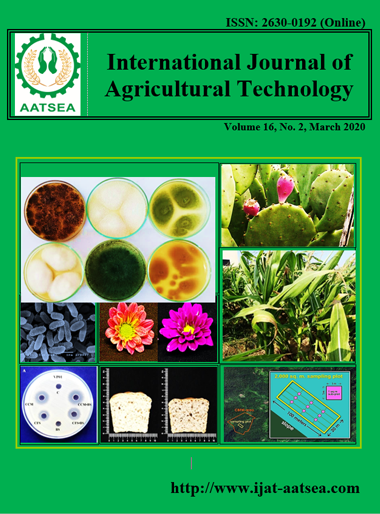Integrated management of corn diseases using biological and natural products
Main Article Content
Abstract
The problems of corn production caused severe losses of foliar diseases eg. streak, leaf blight, gray leaf spot and rust. The study was done to reduce disease incidence and increase the productivity of corn grown in the new reclaimed region. The application of biocontrol agents (Rhodotorula glutnis, Paenibacillus polymyxa, Bacillus subtilis, Pseudomonas putida, Trichoderma harzianum and Marin actimycete) and natural products (potassium silicate and amino acids eg. L-arginine-L-methionine, L-ornithine were clearly investigated. All biological products were actively antagonized the tested fungal pathogens which isolated from corn. Biological and natural products application are improved disease management, yield and quality. P. polymyxa and P. putida are significantly promoted the growth of corn. P. putida, P. polymyxa and natural compounds were proved to be effectively increased total phenols, total soluble protein, chitinase and peroxidase. The protection level of biological treatments in combination with application of natural products was as effective as the application of biological agents alone.
Article Details

This work is licensed under a Creative Commons Attribution-NonCommercial-NoDerivatives 4.0 International License.
References
AOAC (1975). Official Methods of Analysis of the Association of Official Agricultural Chemists (12th ed).Washington DC. pp 1042 Agriculture Science, 29:892-912.
Barros, R. (2011). Estudo sobre a aplicação foliar de acibenzolar-S-metil para indução de resistência à ferrugem asiática em soja e cercosporiose em milho. Arquivos do Instituto Biológico, São Paulo, v.78, n.4, pp.519-528.
Bollag, D. M. and Eldelstein, S. J. (1992). Protein extraction. In: Protein Methods. Bollag DM and Eldelstein SJ (eds). Wiley-Liss Inc, New York, pp. 27-42.
Brito, A. H., VON Pinho, R. G. and Santos, A. O. (2011). Santos, S. Reação de híbridos de milho e comparação de métodos para avaliação da Cercosporiose e Mancha Branca. Tropical Plant Pathology, Brasília, DF, v.36, n.1, pp.35-41.
Chester, K. S. (1950). Plant disease losses: their appraisal and interpretation. Plant Disease Reporter, Washington, 193:191-362, Suplement.
Choudary, D. A., Reddy, K. R. N. and Reddy, M. S. (2007). Antifungal activity and genetic variability of Trichoderma harzianum isolates. Journal of mycology and plant pathology, 37:295-300.
Costa, D. F., Vieira, B. S., Lopes, E. A. and Moreira, L. C. B. (2012). Aplicação de fungicidas no controle de doenças foliares na cultura do milho. Revista Brasileira de Milho e Sorgo, Sete Lagoas, 11:98-105.
Haggag, W. M., Tawfik, H. M. M., Abouziena, F., Abd El Wahed, M. S. A. and Ali, R. R. (2017). Enhancing Wheat Production under Arid Climate Stresses using Bio-elicitors. pringer: Springer Nature ; Gesunde Pflanzen, 69:149-158.
Haggag, W. M. (2018). Development and application of biotechnological products for sustainable corn and soybean production under stresses condition. International Journal of Agricultural Technology, 14:1209-1224.
Haggag, W. M. (2013). Corn diseases and management. Journal of applied sciences research, 9:39-43.
Hasabi, V., Askari, H., Alavi S. and Zamanizadeh, H. (2014). Effect of amino acid application on induced resistance against citrus canker disease in lime plants. Journal of Plant Protection Research, 54:144-149.
Hayat, R., Ali, S., Amara, U., Khalid, R. and Ahmed, I. (2010). Soil beneficial bacteria and their role in plant growth promotion: a review. Annual Microbiology, 60:579-598.
Oerke, E. C. (2006). Crop losses to pests. Journal of Agricultural Science, 144:31-43.
Raaijmakers, J. M., Vlami, M. and de Souza, J. (2002). Antibiotic production by bacterial biocontrol agents. Antonie van Leeuwenhoek, 81:537-547.
USDA (2006). World agriculture production: Crop production tables. Online. Production, Supply and Distribution. USDA-Foreign Agricultural Service, Washington, DC.
Wang, M., Gao, L., Dong, S., Sun, Y., Shen, Q. and Guo, S. (2017). Role of silicon on plant – pathogen interactions. Front Plant Science, 8:701. https://doi.org/10.3389/fpls.2017. 00701
World Food Situation (2016). FAO cereal supply and demand brief". Rome, Italy: United Nations, Food and Agriculture Organization. 8 December 2016.


